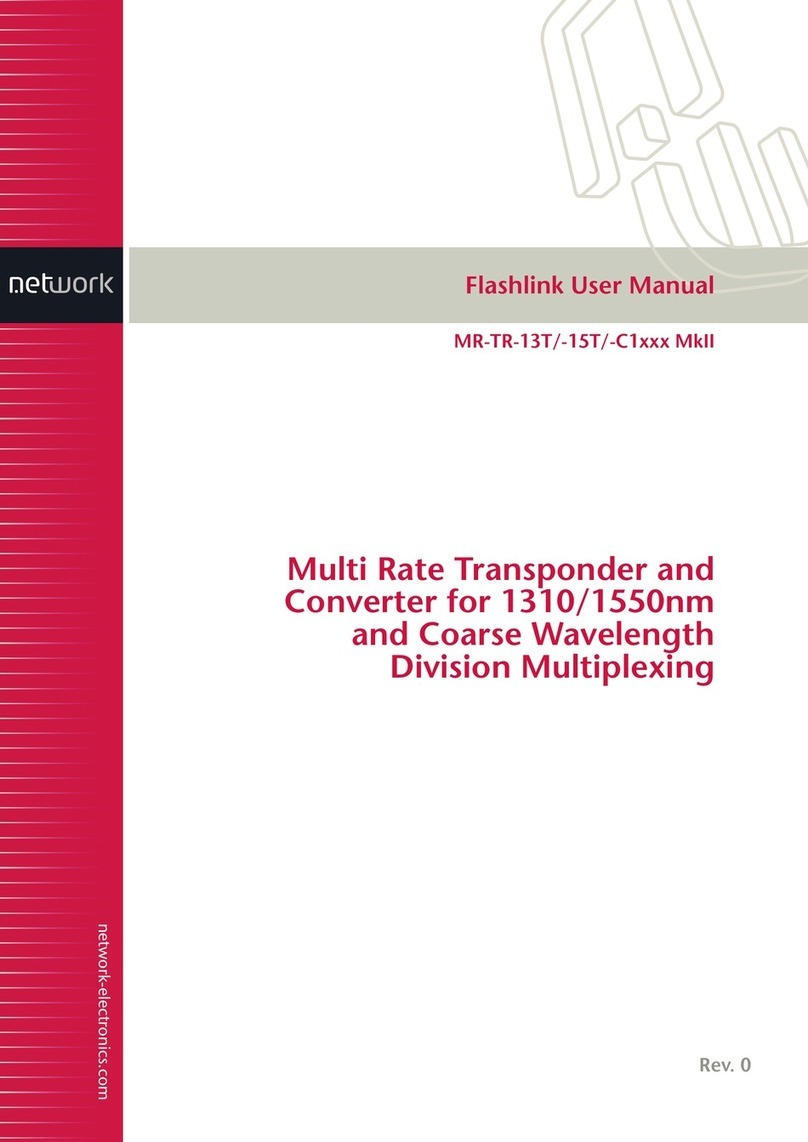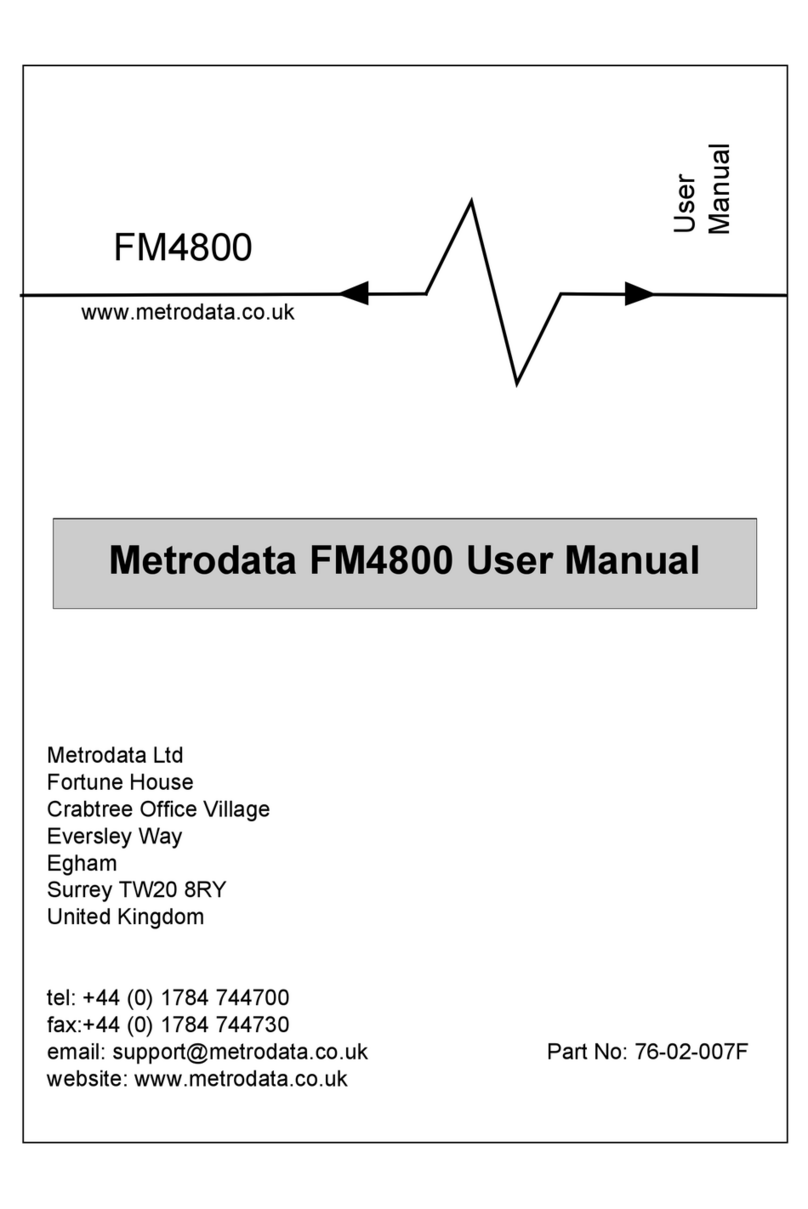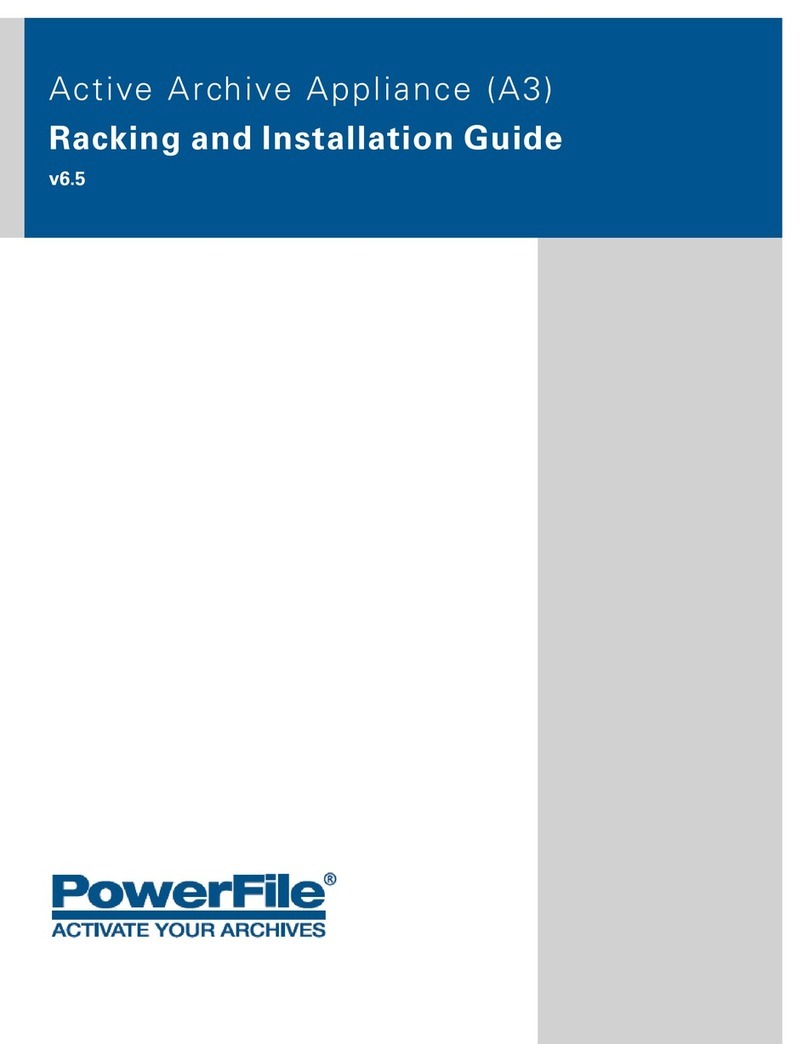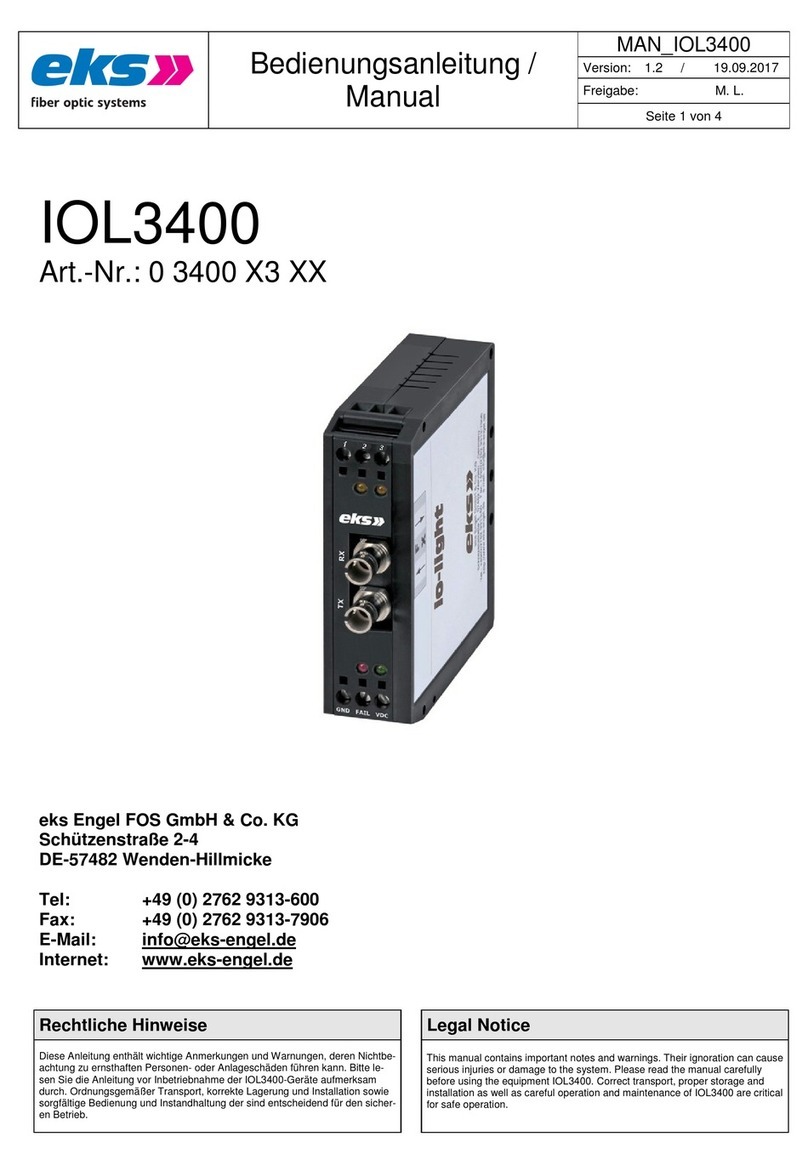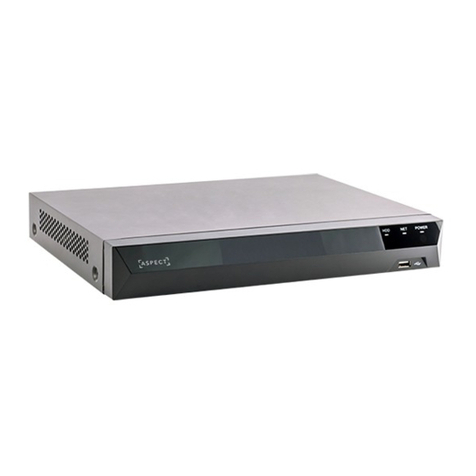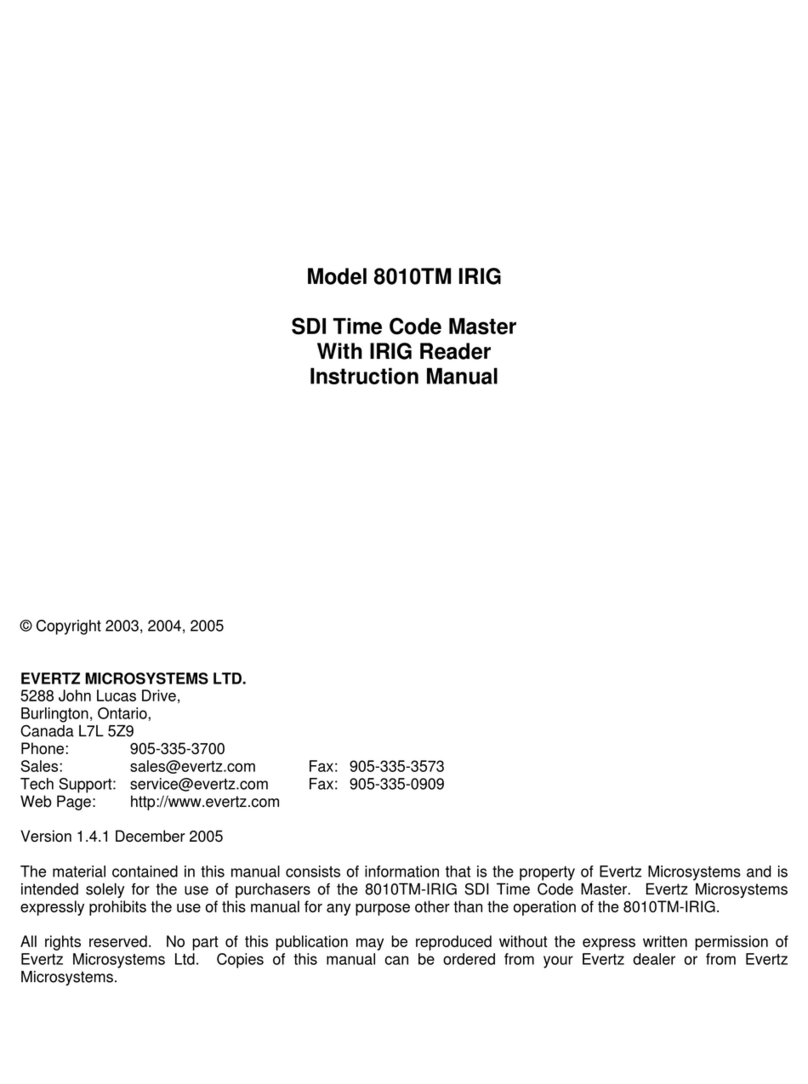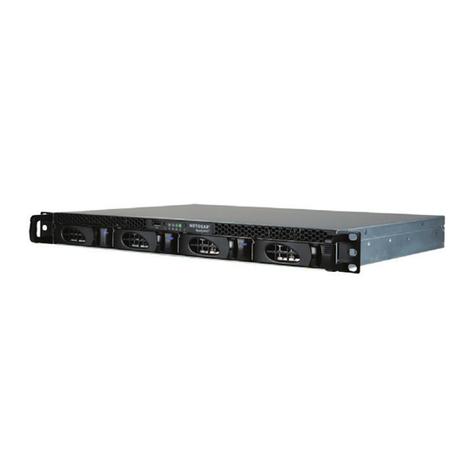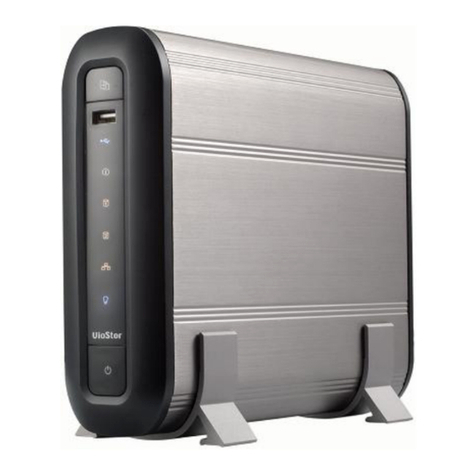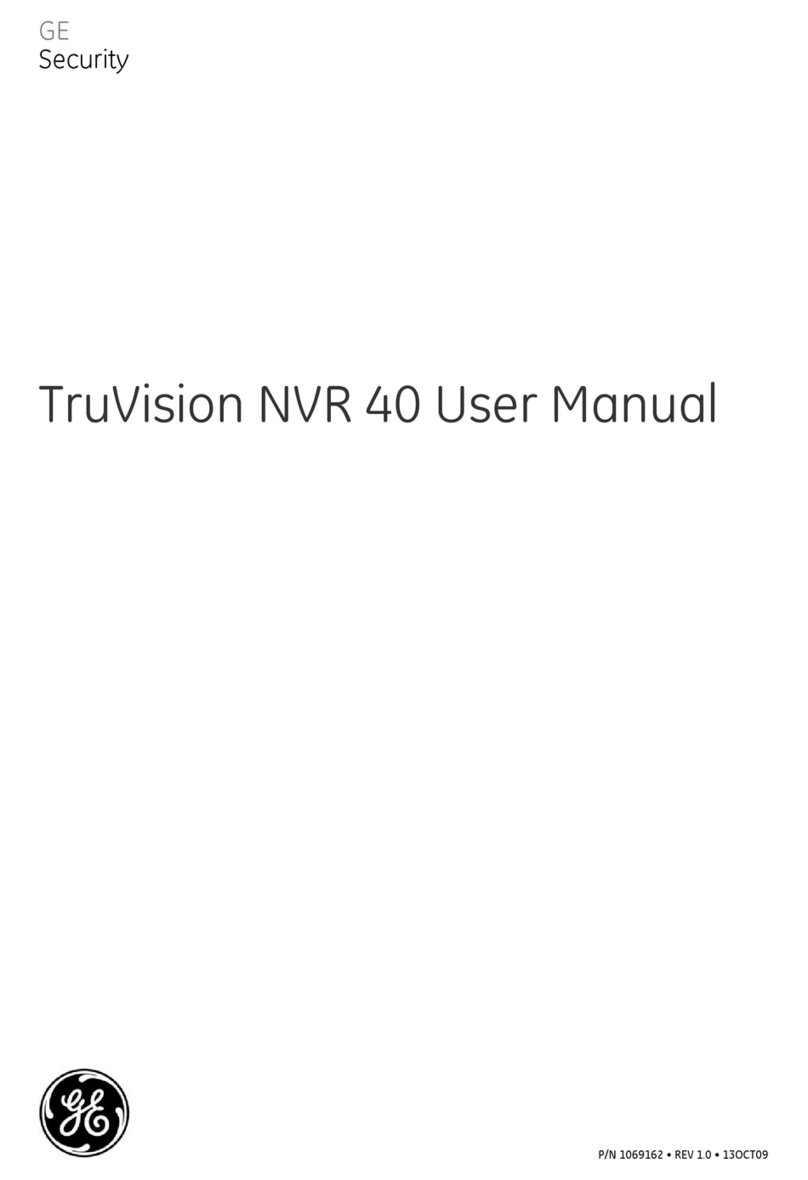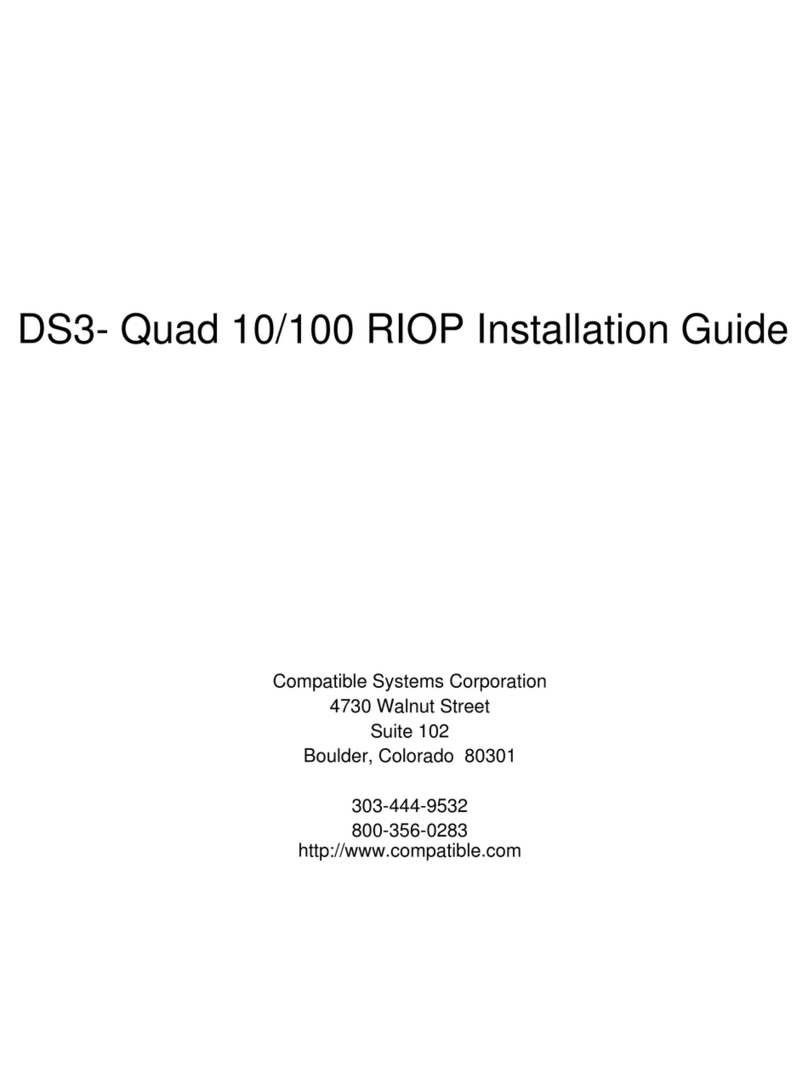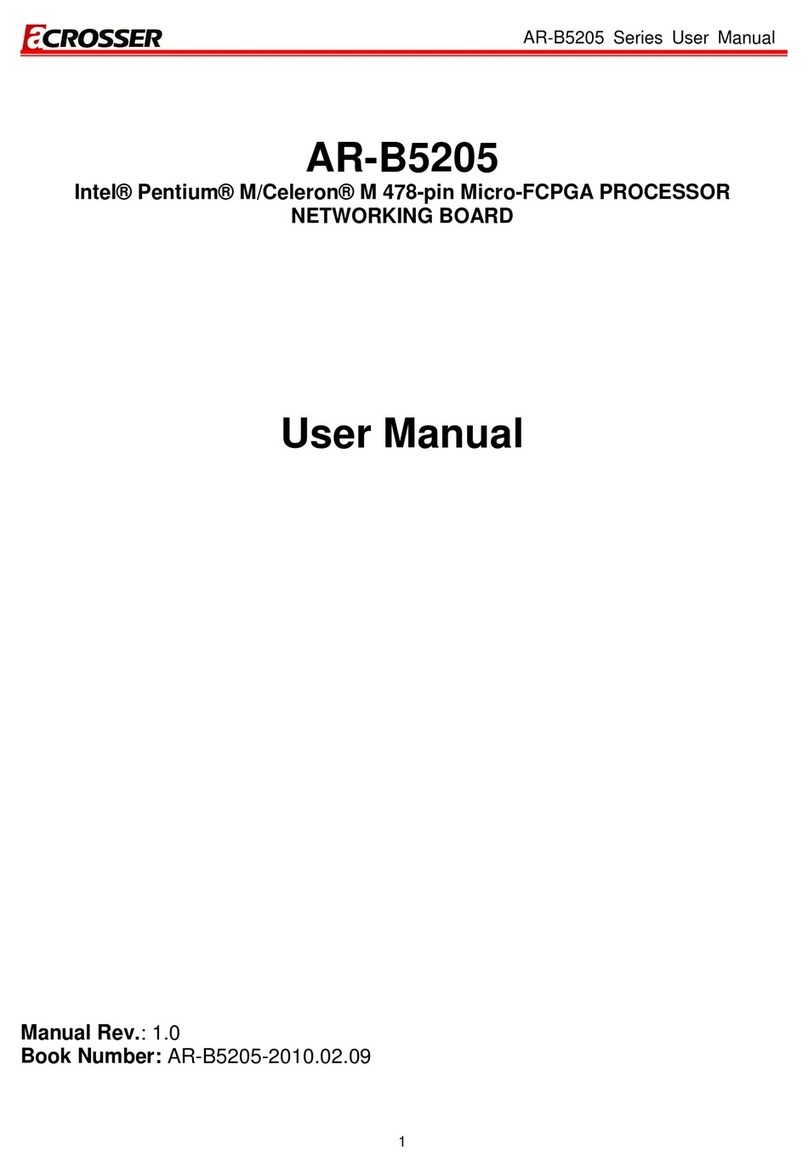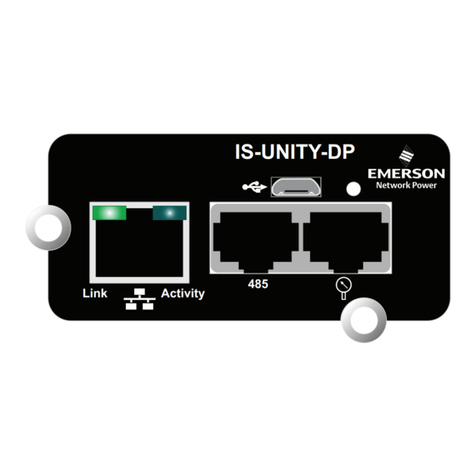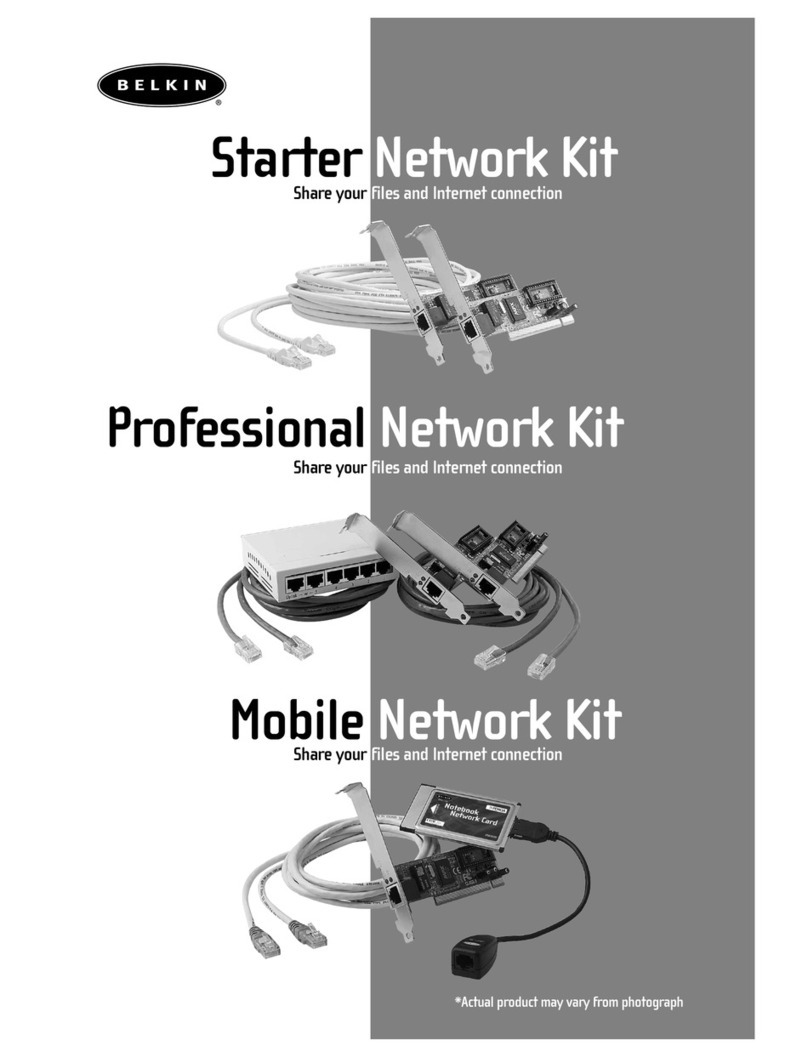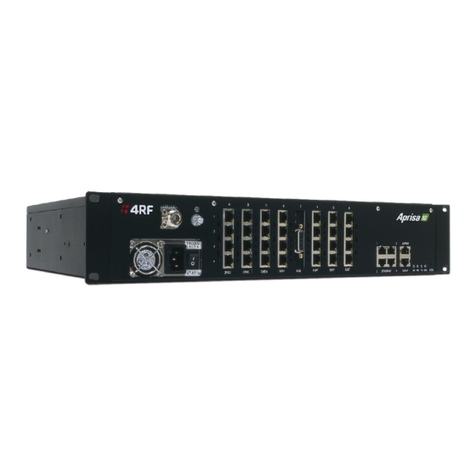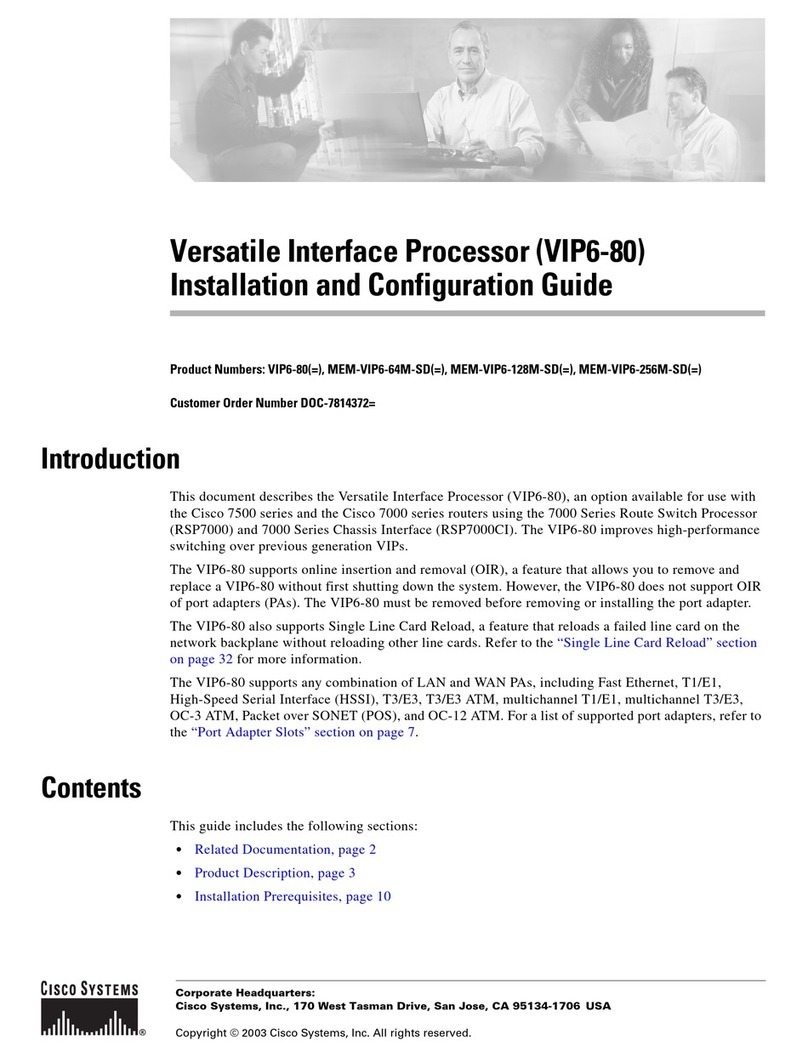network Flashlink LIS-SDI User manual

network-electronics.com
SDI Line Synchroniser
Rev. 2
Flashlink User Manual
LIS-SDI

LIS-SDI Rev. 2
network-electronics.com | 2
Revision history
The latest version is always available in pdf-format on our website:
http://www.network-electronics.com/
Current revision of this document is the uppermost in the table below.
Revision Replaces Date Change Description
2 1 2007-10-26 New front page.
1 0 2007-09-11
Added Materials Declaration and EFUP; updated EC
Declaration of Conformity.
0 A 07.04.05 First official release; no changes to content.
A 09.04.03 Initial version. PIC sw. rev. 1.0.1. Firmware rev. 1.2

LIS-SDI Rev. 2
network-electronics.com | 3
Quick Start Guides for LIS-SDI
Used as a line synchroniser with deglitcher.
1. Attach SDI input and SDI output(s) to the backplane module (see Figure 2 on page 8) and
attach the Black&Burst signal to the backplane. Terminate the Black&Burst signal with
75ohm to ground.
2. Set DIP-switch 1 on (towards backplane). Set DIP-switch 3 on. Leave the rest of the
switches untouched.
3. Insert LIS-SDI into a slot in the sub-rack.
4. Power on. After one second the LIS-SDI should be running, all LEDs should be green, see
section 5.2. Note that up to 12 seconds may be needed to synchronise SDI and Black&Burst
at initial power up.
5. The BCD switches and the pushbuttons must be used to adjust which line and sample the
output will lock to. The output phase must be set with respect to the Black&Burst signal in
such a way that the delay through the card is between 41 samples and 1 line and 41 samples.
(See section 4.3)
Used as a video deglitcher.
1. Attach SDI input and SDI output(s) to the backplane module (see Figure 2 on page 8) and
attach the Black&Burst signal to the backplane. Terminate the Black&Burst signal with
75ohm to ground.
3. Insert LIS-SDI into a slot in the sub-rack.
4. Power on. After one second the LIS-SDI should be running, all LEDs should be green, see
section 5. Note that up to 12 seconds may be needed to synchronise SDI output to the
Black&Burst input at initial power up.
5. The output from LIS-SDI is now delayed ca ½ line with respect to the SDI input. When a
upstream switch is performed and a SDI input with another phase is placed on the input. The
delay through the linesync is changed, but the output phase is the same. When in deglithing
mode, the different SDI inputs must not have phases that differ more than ± ¼ line.
Note that if a GYDA controller is used, switch 1 should be in the off position.

LIS-SDI Rev. 2
network-electronics.com | 4
Index
Revision history........................................................................................................................2
Quick Start Guides for LIS-SDI.............................................................................................3
Used as a line synchroniser with deglitcher..........................................................................3
Used as a video deglitcher.....................................................................................................3
1. General..................................................................................................................................6
2. Specifications ........................................................................................................................7
3. Connector module................................................................................................................8
3.1 Mounting the connector module.......................................................................................8
3.2 Correspondence of connectors and signals .....................................................................8
4. A more detailed description ..............................................................................................10
4.1 Data path........................................................................................................................10
4.2 EEPROM........................................................................................................................10
4.3 Two modes of operation.................................................................................................10
4.4 Power-up sequence ........................................................................................................11
4.5 When an input signal is lost ...........................................................................................11
4.6 Warm up time.................................................................................................................11
5. Module status......................................................................................................................11
5.1 GPI - General Purpose Interface...................................................................................11
5.2 Light Emitting Diodes ....................................................................................................12
5.2.1 Card State....................................................................................................................12
5.2.2 Signal state..................................................................................................................12
5.2.3 Frame Lock .................................................................................................................12
5.2.4 EDH.............................................................................................................................13
6. SWITCHES.........................................................................................................................13
7. Pushbuttons.........................................................................................................................15
7.1 Reset...............................................................................................................................15
7.2 INC and DEC .................................................................................................................15
8. BCD switches......................................................................................................................15
8.1.........................................................................................................................................15
8.2 Lines delay......................................................................................................................16
8.3 Delay range....................................................................................................................16
9. Interface with GYDA or other controllers.......................................................................16
9.1 The '?' command.............................................................................................................16
9.2 The “info” command......................................................................................................17

LIS-SDI Rev. 2
network-electronics.com | 5
9.3 Delay command..............................................................................................................17
9.4 EDH-, Lsync- and TRSReplace-commands....................................................................17
9.5 Get and Set.....................................................................................................................18
General environmental requirements for Network flashlink®equipment.......................20
Product Warranty..................................................................................................................21
Materials declaration and recycling information................................................................22
Materials declaration.............................................................................................................22
Environmentally-friendly use period ...................................................................................22
Recycling information............................................................................................................23
EC Declaration of Conformity..............................................................................................24
List of figures
Figure 1: Simplified block diagram of the LIS-SDI card..............................................................................6
Figure 2: FRS-SDI-C1 connector module.....................................................................................................8
Figure 3: LIS-SDI simplified silkscreen (figure not to scale).......................................................................9
List of Tables
Table 1: Summary of the DIP switches.......................................................................................................13
Table 2: Method to restore the LIS-SDI card to factory settings................................................................14
Table 3: All commands available to the user..............................................................................................16
Table 4: The info command broken up in components...............................................................................19

LIS-SDI Rev. 2
network-electronics.com | 6
Figure 1: Simplified block diagram of the LIS-SDI card
1. General
The flashlink®LIS-SDI line synchroniser synchronizes the output SDI to the Black&Burst
signal with an adjustable phase relative to Black&Burst signal. The LIS-SDI deglitches the
digital signal when upstream switching is performed. It is possible to correct false F (Field), V
(Vertical blanking) and H (Horisontal blanking) bits in TRS sync words. The LIS-SDI has an
option to shift the whole video picture up and down with respect to the Vertical sync.
LIS-SDI user parameters can be changed via switches on the unit, or via the GYDA control
interface.

LIS-SDI Rev. 2
network-electronics.com | 7
2. Specifications
Digital Serial Input
Input format: 270 Mb/s scrambled NRZI (4:2:2
SMPTE 259M-C)
Output level: 800mV nominal, 75ohm terminated
Equalization Automatic up to 35 dB (300 m Belden
8281)
Return loss: > 15 dB
Black&Burst input
Input signal SMPTE 170M/PAL ITU 624-4
Return loss > 35 dB up to 5.75 MHz
Digital Serial Output
Output format: 270 Mb/s scrambled NRZI
Output level: 800 mV nominal
Return loss: > 15 dB
Other
Input voltage DC 5 V
DC –15 V
Power consumption < 3.2 W
Minimum delay 41 video samples
Maximum delay 1 line and 41 video samples

LIS-SDI Rev. 2
network-electronics.com | 8
3. Connector module
The LIS-SDI has its own connector module: FRS-SDI-C1, mounted at the rear of the sub-
rack. See Figure 2.
Figure 2: FRS-SDI-C1 connector module.
3.1 Mounting the connector module.
If the connector module is purchased separately, it should be mounted as described in the user
manual for the sub-rack frame FR-2RU-10-2. This manual is also available from our web site:
http://www.network-electronics.com/
3.2 Correspondence of connectors and signals
The FRS-SDI-C1 connector module has 7 BNC's:
SDO1 Line synchronized SDI output.
SDO2 Line synchronized SDI output.
SDO3 Line synchronized SDI output.
SDI-IN SDI input.
BB Black&Burst input
BB-DUP Black&Burst passive loop through.
SDI-OUT SDI-IN reclocked and buffered.
SDO1, SDO2 and SDO3 are equivalent 270 Mb/s SDI outputs.

LIS-SDI Rev. 2
network-electronics.com | 9
Figure 3: LIS-SDI simplified silkscreen (figure not to scale).

LIS-SDI Rev. 2
network-electronics.com | 10
4. A more detailed description
4.1 Data path
SDI-IN is equalized and reclocked, then transferred bit serially to the FPGA. The FPGA
descrambles and deserializes the input to 10-bit parallel, detects whether it is 625/50Hz or
525/60Hz, and writes the data to the line-buffer.
Data is fetched from the line-buffer, EDH is checked, the data is transferred to a chip that
serializes and scrambles the signal, and drives the resulting 270 Mb/s SDI-signal onto the
output connectors.
4.2 EEPROM
The LIS-SDI card actually has two EEPROM's. A small EEPROM is included in the
microcontroller, while a larger external EEPROM holds the configuration memory of the
FPGA and the input video chip.
Internal EEPROM
State variables are written to EEPROM in the microcontroller each time a configuration
change is made. Basically, the card remember it's setting between power-downs.
External EEPROM
The configuration memory of the FPGA and the input video chip is upgradeable. This is,
however, a task for qualified maintenance personnel.
4.3 Two modes of operation
The LIS-SDI can operate in two modes, with or without linesync (switch 3 or lsync on/off
command). When the linesync mode is off the card is used as a deglitcher. Then the output
phase is not adjustable.
It is recommended that the Black&Burst is connected also when the card is just used as a
deglitcher. The Black&Burst will insure that the output frequency is correct even if the input
signal is lost. When the linesync mode is off, the SDI output is delayed by half a line with
respect to the first SDI input detected. Any SDI used as input to the deglitcher must not be off
phase by more than half a line with respect to any other input presented to the deglitcher.
When the linesync mode is turned on the LIS-SDI is used as a line synchroniser and a
deglitcher. The output is synchronized to the Black&Burst. The output phase is adjustable
over a full frame with respect to the Black&Burst. The internal video buffer is only one line
long. Therfore the phase of the output SDI must be from 41 samples to 1 line and 41 samples
after the input SDI. The internal processing delay is 41 samples. It is important to know the
phase of the input SDI signals.
An example:
If the SDI inputs have a phase with respect to Black&Burst that is 0 lines and 0 samples, then
the user could for instance set the output phase to 0 lines and 700 samples.

LIS-SDI Rev. 2
network-electronics.com | 11
4.4 Power-up sequence
At power-up, the card performs a self-check, and initiation. The manual mode switch is then
sampled. If manual mode is enabled, the other switch settings are read and the state of the
card set accordingly. If manual mode is disabled, the state the card held the previous time it
was used is read from EEPROM. The interplay between the EEPROM, the switches and the
GYDA (or other) controller adhere to the following simple rules:
•If a GYDA controller is present in a system, it can always override manual settings.
•If the manual mode is used together with a GYDA controller, the LIS-SDI will initiate as
determined by the switches, and may then be overridden by the controller.
•If the manual mode is not used, the LIS-SDI will initiate as determined by the state of the
EEPROM. It is subsequently controlled by the GYDA controller.
•At any time, when a state change is done, whether it is by switches or GYDA, the state is
stored in the EEPROM as soon as it is detected.
4.5 When an input signal is lost
If SDI input disappears
If the SDI input disappears the output will be blanked SDI video.
If Black&Burst disappears
Given that stable SDI input and Black&Burst exists. If the Black&Burst disappears, the SDI
input will still be output, but there are two important differences:
The internal clock will now be locked to the SDI input clock. The lsync mode (linesync
mode) is now disabled.
If both inputs disappear
The output will be black video locked to the onboard crystal. This is not a reference clock,
and drift out of video specification cannot be precluded.
4.6 Warm up time
The LIS-SDI uses a voltage controlled crystal oscillator (VCXO) to generate a clock that is
locked to Black&Burst or SDI. At power up the LIS-SDI may use as much as 12 seconds to
lock to a Black&Burst or SDI source.
5. Module status
5.1 GPI - General Purpose Interface
The GPI output is an open collector output.
Max current: 100mA
Summary: The LIS-SDI card remembers the settings it had the last time it held power.

LIS-SDI Rev. 2
network-electronics.com | 12
Max voltage: 30V
FRS-SDI-C1 GPI pinning:
Pin 1 Status General error status for the module.
Pin 2 SDI input No SDI input.
Pin 3 Black&Burst Black&Burst not detected.
Pin 4 EDH CRC error detected.
Pin 8 Ground 0 V
5.2 Light Emitting Diodes
LIS-SDI implements four Light Emitting Diodes (LEDs) that show the state of the card. The
LEDs are visible through the front-panel of the rack (see the user manual of FR-2RU-10-2 for
details). The LEDs are described top-down, see also Figure 3 on page 9.
5.2.1 Card State
No Light No power, fuse F1 blown, LED malfunction or configuration memory lost.
Red A fundamental, probably electrical, error has been detected. The card is set in a passive state,
so that it does not disturb other cards in the rack. While powering on, the CardState LED will
light red for approximately 0.5 s while the card undergoes self-test.
Yellow The startup-sequence is running. The card is not yet ready
Green LIS-SDI is powered and ready.
5.2.2 Signal state
No Light Not used.
Red No SDI input.
Yellow Week SDI input
Green SDI input.
The “Signal state” LED will turn red for a short moment when there is an upstream switch in
the SDI signal. This indicates that the LIS-SDI has detected a broken video stream and the
output is switched to the internal video generator.
5.2.3 Frame Lock
No Light Not used.
Red No Black&Burst input.
Yellow Black&Burst input, not yet locked.
Summary: Green LEDs are good, red LEDs are bad.

LIS-SDI Rev. 2
network-electronics.com | 13
Green Black&Burst present, locked.
During normal operation, the status of the Black&Burst input is shown on this LED. The
LED is used as an indicator if the pushbuttons are used to adjust delay. (See section 7.)
5.2.4 EDH
No Light Not used.
Red CRC error detected.
Yellow Not used.
Green No error detected.
6. SWITCHES
The LIS-SDI card implements a Dual-Inline switch (DIP-switch) that provides 10 individual
On/Off switches. The purpose of the switches is to offer you an easy interface to some
features of the LIS-SDI card, without the need of a GYDA controller. Table 1 gives the
general layout of the switches. The switches are numbered from '1' at the top and downwards
to the bottom, see Figure 3. A switch is on when the tap is displaced in direction of the back-
plane.
The LIS-SDI card is shipped with all switches, except switch 10, in the Off-position. Switch
number 10 should always be in the On-position. The switches are discussed in logical rather
than numerical order.
Switch # Function Comment
1 Manual mode on/off When on, enables switches 2, 3, and 4.
2 EDH disable on/off When on, the EDH will not be inserted into the SDI-output.
3 Line sync on/off When on, the output timing is referenced to Black&Burst.
4 TRS Replace on/off When on, the digital sync words from the internal video
genratot is used instead of the sync from the incoming SDI.
5 Reserved
6 Reserved
7 Reserved
8 Factory Reset on/off To restore internal EEPROM only
9 Reserved
10 Running mode on/off For factory use only.
Table 1: Summary of the DIP switches.
Switch 5, 6, 7, 9 and 10 are mainly for factory use, while switches 1, 2, 3 and 4 will be used
when no GYDA controller is available.
Switch 10 - Programming mode
Switch 10 is purely used for service upgrade of the LIS-SDI card. It should always be in the
on position. If switch 10 is in the off position, the CardState LED will light up red, and the
Summary: Most users will probably want switches 1 to 9 in the off position. All users
should place switch 10 in the on position.

LIS-SDI Rev. 2
network-electronics.com | 14
LIS-SDI card will enter programming mode. This causes no harm, but the card will not work
in this mode.
Factory setting is switch 10 in on position.
Switches 5, 6, 7 and 9 - Reserved
These switches are reserved for future expansion, and should always be in the off position.
Factory setting is switch 5, 6, 7 and 9 in off position.
Switch 8 - Reset to factory default
LIS-SDI contains EEPROM that is affected by your choices. Switch 8 is implemented to reset
the EEPROM to factory default. Its use is shown in Table 2.
Action Comment
Power down.
Turn switch 8 on.
Power up. LIS-SDI enters a special state where the EEPROM is restored to factory default
values. This is flagged by the LEDs, they are all yellow.
Power down.
Turn switch 8 off. If you want the DIP switches to be placed in the factory default position, this is the
time to do so: Turn switches 1 through 9 to the off position. Switch 10 should, as
always, be turned to the on position.
Power up. The card EEPROM is now reset to factory settings.
Table 2: Method to restore the LIS-SDI card to factory settings.
Remember to let some seconds pass by each time you power down, to allow capacitors to be
fully discharged.
Switch 1 - Manual mode
Switch 1 is the manual mode switch. If on, the LIS-SDI is primarily assumed to be operated
with switches alone. If off, the LIS-SDI is assumed to be used with a GYDA controller.
Factory setting is switch 1 in off position.
With switch 1 off
While in automatic mode, switches 2, and 3 are without any effect.
With switch 1 on
In manual mode, the functionality of switches 2, and 3 is as follows:
Switch 2
Switch 2 turns on/off disabling of EDH in the output SDI. With switch 2 off, the EDH is
included in the SDI signal, with switch 2 on, EDH is not included.
Factory setting is switch 2 in off position.
Switch 3
Switch 3 turns on/off the line sync mode. With switch 3 off, the video output is delayed half a
line with respect to the first SDI input detected. The LIS-SDI tolerates upstream video
switching on the input SDI. The deglitching only works if any of the different SDI inputs has
a phase difference not more than half a line from any of the other SDI inputs that will be used
with the LIS-SDI.

LIS-SDI Rev. 2
network-electronics.com | 15
With switch 3 on the output phase can be adjusted with respect to the Black&Burst. This is
called linesync mode. The output must be adjusted to a phase that keeps the total delay
through the card between 41 samples and 1 line and 41 samples.
Switch 4
Switch 4 turns on/off the TRS-Replace mode. With 4 off the LIS-SDI is transparent to the
video data. With switch 4 on the LIS-SDI will replace the SDI sync words with the sync word
generated by the internal video generator. This is a way to correct video that has wrong sync
words. When both switch 3 and switch 4 is placed in the on position, it is possible to do a
vertical shift of the video data with respect to the video sync words. Be careful. Audio and
edh-information is also shifted. The LIS-SDI will generate EDH information on the correct
EDH line after the vertical shifting.
7. Pushbuttons
LIS-SDI contains three pushbuttons.
7.1 Reset
The lower pushbutton is a reset switch (see Figure 3). It has the same effect as a power-on.
7.2 INC and DEC
These two buttons is used to fine adjust the horizontal delay in samples from 0 to 1715 in
525/60Hz and from 0 to 1727 in 626/50Hz.
The INC button will increase the delay and the DEC button will decrease the delay. There is
no wrap-around. The INC and DEC buttons will work even if Switch 1 (see section 6) is not
set to manual mode.
8. BCD switches
LIS-SDI contains four BCD switches. These switches are used to set the delay when the DIP-
switch 1 is set to manual mode, see section 6.
8.1
The upper BCD switch is not used on the LIS-SDI.
8.2 Lines delay
The second BCD switch from the top is used to adjust the phase in steps of hundred lines.
Summary: The phase of the outgoing video with reference to Black&Burst may be adjusted.

LIS-SDI Rev. 2
network-electronics.com | 16
The third BCD switch from the top is used to adjust the phase in steps of ten lines.
The last BCD switch is used to adjust the phase in steps of 1 line.
The phase in lines is set with respect to Black&Burst when Black&Burst is detected and is
not used when Black&Burst is absent.
8.3 Delay range
The minimum delay through the LIS-SDI is 41 27MHz video samples. The maximum delay
through the card is 1 line and 41 27MHz samples.
9. Interface with GYDA or other controllers
LIS-SDI follows the flashlink®-protocol, see the definition of the protocol available from our
web site:
http://www.network-electronics.com/. LIS-SDI can also be used with any controller or
controller system that adheres to the flashlink®-protocol, using the RS422 bus. For more
information on the electrical interconnect, see the documentation of FR-2RU-10-2. The
available commands are shown in Table 3.
Command Response Comment
? Yes The “Hello” command.
info Yes Gives back the card state.
EDH on xxxxOK Turn on EDH in output SDI.
EDH off xxxxOK Turn off EDH in output SDI.
Lsync on xxxxOK Set lsync mode on.
Lsync off xxxxOK Set lsync mode off.
TRSReplace on xxxxOK Replace SYNC words.
TRSReplace off xxxxOK Use orignal sync words.
delay [xxx] [xxxx] xxxxOK Set the delay in lines and samples.
get [0xHH] Yes Get a value from a numbered register.
set [0xHH] [0xHH] No Set a value to a numbered register.
Table 3: All commands available to the user
9.1 The '?' command
According to the flashlink®-protocol, no card can use the RS422-bus before the '?' (hello)
command is sent the card at least once. The response from LIS-SDI will be:
xxxxLIS-SDI\
PIC sw rev X.X.X\
FPGA sw rev X\
Protocol ver X.X
Here xxxx denotes the source and destination rack and slot coordinates, while Xrepresents a
version number. As of medio April 2003, these revisions would be:
xxxxLIS-SDI\

LIS-SDI Rev. 2
network-electronics.com | 17
PIC sw rev 1.0.2\
FPGA sw rev 1.2\
Protocol ver 1.0
9.2 The “info” command
This command reports the entire state of the card. An example:
xxxxSDI signal strength > 90\
BBurst detected and frq. locked\
Lsync enabled, delay ref. to BB line: 0, sample: 0\
Video standard: 625\
No EDH: 0\
Error full field:\
crc: 0\
unk: 0\
ues: 0\
ida: 0\
idh: 0\
eda: 0\
edh: 0\
Error active video:\
crc: 0\
unk: 0\
ues: 0\
ida: 0\
idh: 0\
eda: 0\
edh: 0\
The “info” command is composed by many minor lines, fully specified in Table 4. In general,
when a condition is normal, it is not reported. For instance, EDH will normally be enabled, it
is only when it is disabled it's state is reported.
9.3 Delay command
The delay command sets the output phase in lines and samples with respect to Black&Burst.
Example:
xxyydelay 178 1267
The output SDI output has a phase delayed 178 lines and 1267 samples with respect to the
Black&Burst.
9.4 EDH-, Lsync- and TRSReplace-commands
Commands to turn on/off the lsync-feature, TRSReplace or the EDH inclusion in the SDI
output are both straightforward text, see Table 3.

LIS-SDI Rev. 2
network-electronics.com | 18
9.5 Get and Set
These commands are factory internal. The end-user should avoid these commands:
Status of Status string Comment
No SDI input SDI input is not detected.
SDI signal strength > 90 % Strong SDI signal.
SDI signal strength < 10 % Weak SDI signal.
SDI input
SDI signal strength = %d % %d is a number from 10 to 90.
No BBurst input No Black&Burst detected.
BBurst detected not locked LIS-SDI is unable to synchronize the analog output to
the detected Black&Burst input. The Black&Burst
signal may be out of LIS-SDI's frequency range.
Black&Burst
BBurst detected and locked LIS-SDI generates analog output synchronized to the
detected Black&Burst input signal.
EDH insertion disabled No EDH information in SDI output.EDH (No EDH status string) EDH information is included in SDI output.
Locked to Bburst line: xxx,
sample: xxxx xxx is an integer from 0 to 624 and xxxx is an integer
from 0 to 1727. This line indicates that the card is in
Lsync mode.
Delay
Lsync disabled, delay ref. to BB
line: xxx, sample: xxxx The card is not in Lsync mode and is used as a
deglitcher. Black&Burst is not used as an output
timing reference, only as a frequency reference. The
xxx and xxxx shows what the reference would have
been if lsync were enabled.
TRS Replace on The incoming video SYNC words are replaced with
the SYNC words generated by the internal video
generator.
TRS Replace
(No TRS Replace string) The incoming video SYNC words are used as it is.
Video standard 625 The video standard is 625 lines/50HzVideo
standard Video standard 525 The video standard is 525 lines/60Hz
No EDH: %d Count fields where EDH is absent.
Error full field: Label to present next 7 lines as “full field”-error
counters.
crc: %d Full field CRC-error is detected here.
unk: %d Unknown status-flag is detected.
ues: %d Unknown error status-flag is detected.
ida: %d Internal error detected already-flag is detected.
idh: %d Internal error detected here-flag is detected.
eda: %d Error detected already-flag is detected.
edh: %d Error detected here-flag is detected.
Error active video: Label to present next 7 lines as “active video”-error
counters.
crc: %d Active video CRC-error is detected here.
unk: %d Unknown status-flag is detected.
ues: %d Unknown error status-flag is detected.
ida: %d Internal error detected already-flag is detected.
idh: %d Internal error detected here-flag is detected.
EDH
eda: %d Error detected already-flag is detected.

LIS-SDI Rev. 2
network-electronics.com | 19
edh: %d Error detected here-flag is detected.
%d is a decimal number from 0 to 65535 for all the 15 EDH counters above.
Table 4: The info command broken up in components.

LIS-SDI Rev. 2
network-electronics.com | 20
General environmental requirements for Network flashlink®
equipment
1. The equipment will meet the guaranteed performance specification under the following
environmental conditions:
•Operating room temperature range 0°C to 40°C
•Operating relative humidity range up to 90% (non-condensing)
2. The equipment will operate without damage under the following environmental
conditions:
•Temperature range -10°C to 50°C
•Relative humidity range up to 95% (non-condensing)
Table of contents
Other network Network Hardware manuals

